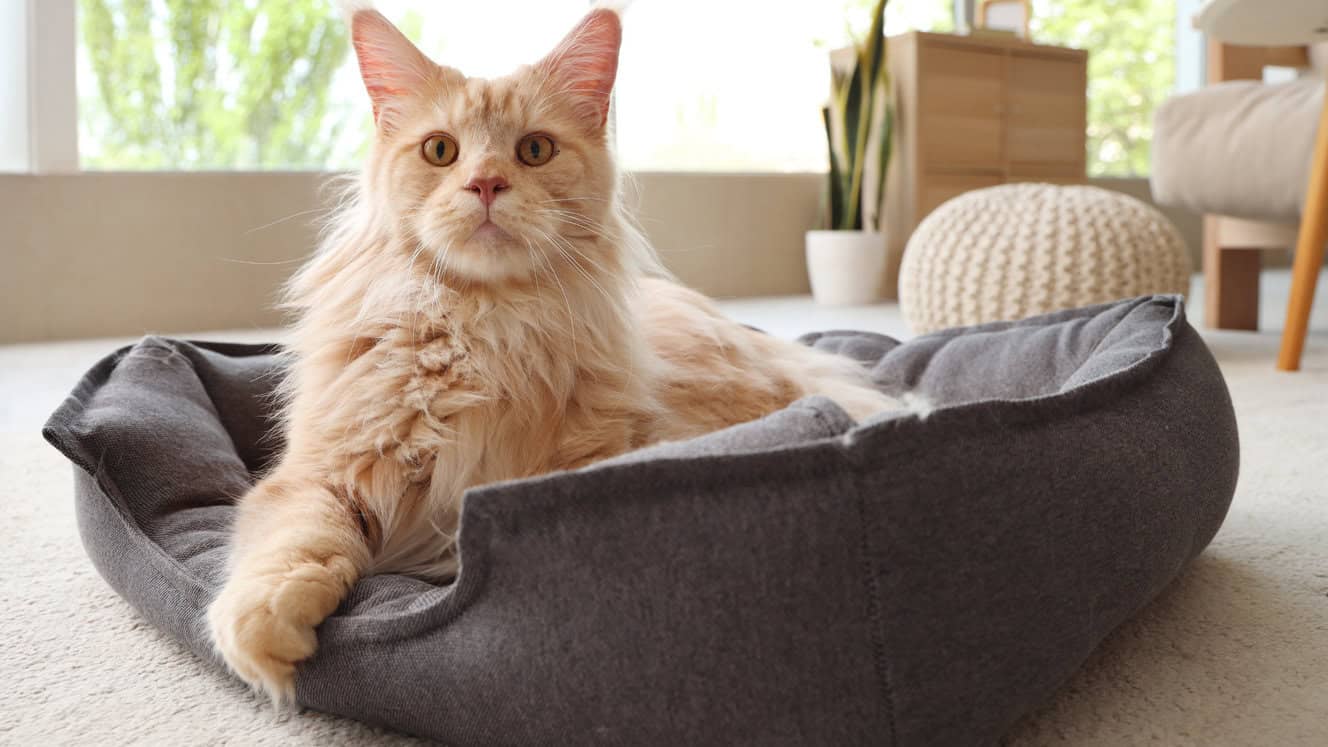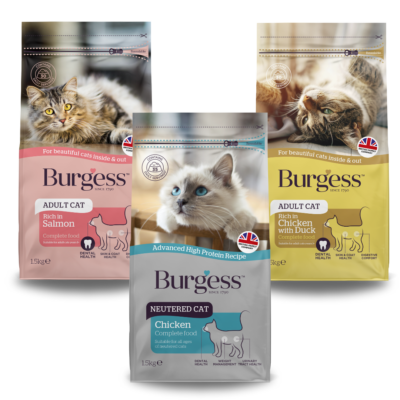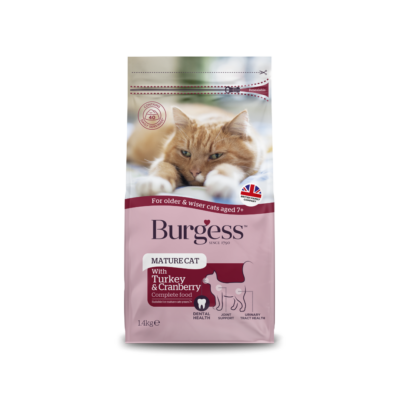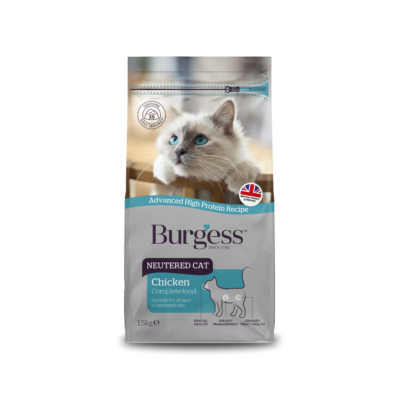
Whether you have a super smart Maine Coon, creature of habit Persian, easy-going British Shorthair, attention-seeking Ragdoll, or outgoing Siamese – do you often wonder what’s really going on in that enigmatic feline brain?
Take a closer look at some of the UK’s most popular cat breeds >>
As far as your favourite feline is concerned, they’re spelling out exactly how they’re feeling via their eyes, ears, body and tail – and are probably rather miffed that you’re not reading all the signals they’re giving you.
Cats Protection advises: “Cats are subtle and complicated in the way they communicate, but taking time to learn their body language can help to strengthen the relationship with your cat. Learning the signs that they are happy, or when they just want to be left alone, can be a big help to you both.”
How to tell when your cat is feline good
Happy cat signals include forward facing ears, a straight up tail (with flat fur, if it’s standing on end, your cat is either angry or frightened), and, if they approach you with an arched back (again with relaxed, flat fur) they’re pleased to see you and welcome your touch. If they’re lying on their side with their tummy exposed, then you can gauge they’re feeling pretty chilled and contented.
BEHAVIOURS OF A HAPPY CAT
- Their tail may wave gently and rhythmically from side to side, usually when held off the ground, but it should not be ‘swishing’/’thrashing’ or ‘thumping’.
- Your cat may produce a low-pitched, pleasant and non-urgent sounding purr.
- Your cat will either appear calmly interested in their surroundings, so not ‘alert’ or ‘agitated’, or they may be relatively uninterested in what’s going on around them.
- Your cat might doze or groom themselves in a relaxed manner.
- A relaxed cat will behave as normal for them and move around the home as they usually would.
- Your cat should eat, drink, groom, go to the toilet, and sleep in regular, healthy amounts.
Source: Battersea
Yowls, growls and miaows? Explore our cat communication guide >>
A happy cat is one that has all their individual requirements and whims met by their devoted human.
“Much the same as humans, your cat will feel happy when all their needs are being met and they feel relaxed and comfortable,” advises Battersea. “Your cat might feel these positive emotions in a few different situations, so there are a range of body language cues to look out for that can help you understand whether your cat is happy.”
Cats Protection adds: “The position of a cat’s tail will usually give away a lot about their mood. If they approach you with their tail up in the air and a slight curve at the tip, this shows that they’re happy to see you.”
THE NEXT BIG STEP FOR YOUR LITTLE CAT When does your kitten become a cat? What changes will you see in their behaviour? When do you need to switch them over from kitten to adult cat food – and what are the nutrition differences that benefit them as they grow?
Feline happiness boosters
Importantly, there are lots of things you can do to boost your favourite feline’s happiness levels. Battersea adds: “Similar to humans, you can keep your cat happy by making sure all their basic needs are met and ensuring they have the opportunity to engage with humans, and different fun things like toys and activities on their own terms.”
‘On their own terms’ is key here. Cats Protection says: “It’s important to remember that like humans, all cats are individuals. One cat may find happiness sitting on their owner’s lap and being stroked. Another may enjoy sitting at a distance nearby with their own space. Take the time to get to know your cat. Find out what they enjoy, so you can give them more of what they like.”
Salmon, chicken, duck? Give your fussy feline a choice with our Adult Cat Bundle! >>
Cats Protection has some great suggestions to add a little extra happiness to your favourite feline’s life:
1. PLENTY OF PLAYTIME Providing your cat with appropriate play allows them to exhibit their natural hunting behaviours. It is also a great way for you to bond with your cat. Have several short play sessions with your cat every day. Ideally three to four play sessions of no more than five minutes. Fishing rod toys are great as they can mimic the behaviour of prey. Allow your cat to catch the toy about once every three times they pounce. This will avoid frustration and release feel-good chemicals called endorphins in their brain. Always end the play session with them catching the toy. Provide a selection of toys for your cat to play with on their own too. Ping pong balls are fun for your cat to knock around. Regularly swap around their toys so that they don’t lose their novelty.
2. TEACH THEM A NEW SKILL Positive, reinforcement-based training is a great way to bond with your cat and teach them some useful life skills. Training sessions should be kept short. About five minutes at a time is ideal. Always set your cat up to succeed to avoid frustration. You can find out how to train your cat to sit, roll over, respond to their name and more.
3. MAKE FEEDING TIME FUN Using puzzle feeders for your cat’s meals provides them with mental stimulation. It also releases feel-good chemicals called endorphins in their brain. Dividing your cat’s daily food allowance into smaller meals meets their need to eat little and often. If your cat is used to being fed from a bowl, they might be unsure about eating from puzzle feeders initially. Once they’ve got the hang of it, you can gradually increase the difficulty to keep it challenging!
4. GET TO KNOW THEM Recognising your cat’s body language, especially the more subtle signs, is an important way to know if your cat is happy. If your cat approaches you with an upright tail, sometimes curved at the tip, this usually means they’re happy to see you. Slow blinking also indicates that your cat feels happy and relaxed in your presence. Your cat may also roll onto their back to show you they trust you. But don’t betray this trust by stroking their belly! If your cat crouches low to the ground, flattens their ears to their head or has very wide pupils in their eyes, this may show that they are feeling anxious or stressed.
5. GIVE THEM SOMEWHERE TO HIDE When thinking about making your cat happy, it’s important to consider their environment. Cats love getting up high especially when they are stressed. Providing them with lots of places they can get up off the ground will keep them happy. Vertical space can be provided by adding cat shelves to your wall, or with cat trees, radiator beds or even cardboard boxes. Cardboard boxes also provide great hiding places, as do igloo beds. Cats like to hide when they feel stressed, as it helps to calm them down. If you have more than one cat, make sure that you are providing enough hiding places for them. Provide one per cat plus one extra. This applies to other essential items as well, such as litter trays, food and water bowls and scratching posts.
And of course, with cats being cats, that toy they loved yesterday is of no interest today, they prefer to snooze on that neat pile of freshly ironed laundry rather than in the cosy cat igloo you bought them and, after you’ve just let them in, they want to go out again... But that’s why we love them and always want them to be happy!
How feeding a high-quality diet can help your cat lead a happy and healthy life
Cats Protection advises: “Always choose a ‘complete’ cat food, one that contains all the nutrition they need in one single food source. This will make sure they’re getting all the vital nutrients they need. Make sure you’re choosing the correct food for your cat’s age. If your cat prefers dry food, remember that a surprisingly small amount will provide them with a square meal. In order not to overfeed, you’ll likely need to weigh this out to make sure they’re getting the right amount. As it contains less water, you may notice them drinking a little more than if they were on wet food.”
EVERY CAT DESERVES A DELICIOUS, NUTRITIOUS DINNER!
At Burgess Pet Care, all our cat food is made using premium ingredients, locally sourced wherever possible to support British farmers, to ensure excellent quality and superior taste to help keep your cat happy and healthy – from kitten, to adult and mature and our award-winning variety for neutered cats.
WHY CHOOSE BURGESS CAT FOOD FOR YOUR BEST FELINE FRIEND?
Here are 5 good reasons that your cat will thank you for!
- COMPLETE NUTRITION Each of the recipes in the Burgess Cat Food range are complete, providing all the nutrients cats require throughout their life in exactly the right proportions.
- PORTION CONTROL With dry food, it’s easy to measure out the right sized portion to help your cat maintain a healthy weight.
- HEALTHY AND SAFE The thorough cooking process ensures that any harmful bacteria, such as salmonella, and viruses are destroyed, and the dry food stays fresh inside the pack.
- TEETH FRIENDLY Dry cat food has the added benefit of exercising your cat’s chewing muscles and provides a mild cleaning effect on the teeth.
- MADE IN BRITAIN Crafted at Burgess Pet Care’s own factory in the heart of Yorkshire by vets and animal nutrition experts, Burgess Cat Food contains high-quality ingredients that meet stringent specifications, locally sourced wherever possible to support British farmers.
But don’t just take our word for it! With a whole host of *5-STAR reviews*, Burgess cat food customers have told us:
* “My cat will not eat wet salmon food but loves this dry variety.” * “We have an old cat and thought we would try it as she seems to have gone off her normal varied food. She loves it.” * “Cats absolutely love it. Couldn't wait for me to open the bag. As one tried to eat through the bag to get to the fishy goodness.” * “Cats really, really love them.” * “It’s great value to buy the large sacks. It arrived promptly. My cat is always keen to eat every last crumb.” * “My cats love it – they can't get enough!” * “Cat loves the food and helps keep him in great health.” * “Kittens love it.” * “My cat loves it, seems to have eased her urinary tract issues too.” * “This is my cat's favourite dry food. *
Our cat diet and nutrition guide is here to help you create a meal plan that's tailored especially for your feline friend!
HOW OFTEN SHOULD YOU FEED YOUR CAT? Find out why little and often suits most cats – and the reason why play should be part of your feeding routine…
Is your cat a Burgess cat? Join the Burgess Pet Club for exclusive offers and rewards.
If you found this interesting, you may also like:
LONG LIVE CATS! The world’s oldest cat – Creme Puff, from Austin, Texas – lived to see her 38th birthday earning her a place in the Guinness Book of Records. While reaching such a great age is rare, the average lifespan our pet cats is between 15 to 17 years, with some even reaching their 20s. Follow our 12 top tips to help your cat enjoy a happy, healthy and long, long life.
ENRICHING THE LIVES OF INDOOR CATS If your older cat now spends more time indoors, find out how to make their life more fun.
COME IN FROM THE COLD Practical ways from feline experts to help your cat cope with winter.
DOES YOUR CAT KNOW THEIR NAME? Whatever name we choose to bestow upon our beloved pet cats, does it make any difference to them? Do they actually understand that they’re called Alfie or Bella or even Archibald von Snugglemuffin?
WHY YOUR CAT ALWAYS WANTS TO BE THE CENTRE OF YOUR WORLD Does your cat constantly sit on your stuff? Does your best feline friend seem determined to get in the way of whatever task you’re trying to do? And have you ever wondered why?
HOW TO TELL IF YOUR CAT REALLY LOVES YOU While you may adore your captivating cat, how does your enigmatic feline companion feel about you?
IS YOUR CAT REALLY MAD AT YOU? Whether it’s because you’ve had to take them to the vet, or you accidentally stepped on their tail, your cat may give you the impression that they’re really cross with you. But can cats really hold grudges?
ARE YOU AND YOUR CAT MORE ALIKE THAN YOU THINK? If you have a grumpy Tabby cat, a super friendly Ragdoll cat, or fiendishly feisty Bengal cat, could this actually say more about you than your pet?
MY CAT IGNORES ME – WHY Unlike dogs, who generally want to be involved in every situation, cats are known for being independent. While some cats can be quite social, it can be hard to take when your favourite feline seems to take absolutely no notice of you. So why is this the case?
STRANGER DANGER! Does your cat do a disappearing act when visitors appear? Unfamiliar humans entering their territory can send them running for cover. So why is this the case?
BEST FELINE FRIENDS FOREVER? For cats, their territory (your home and the surrounding environs) is everything and the arrival of a new feline will be viewed with the utmost suspicion. While humans may think their solo feline will enjoy the company of playmate, your cat is likely to have other ideas.
GIRLS V BOYS – FELINE MYTHS AND MISCONCEPTIONS Do male and female cats act differently because of their gender? Are generalisations about laid back, lap-loving boys and aloof, independent girls simply myths – or is there any truth to them?
THE HOMING INSTINCT – CAN CATS REALLY FIND THEIR WAY HOME? Top tip – it’s much easier if they’re microchipped! Plus, what a change in the law will mean for every cat owner…

















